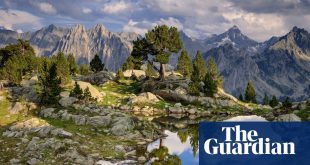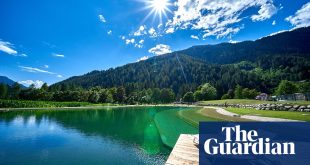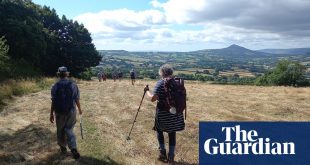Gorgeous Greece has always been a classic, go-to summer holiday destination, and the pandemic served as a stark reminder that tourism is the main motor driving the economy. As a result, many new initiatives were rushed through: from improving infrastructure and promoting sustainability to developing lesser-known destinations.
Early projections suggest that these measures have succeeded and, if all goes well, 2022 could be a bumper season, with tourism reaching 80-90% of pre-Covid levels. So maybe this is the year to discover an out-of-the-way beach or an underrated resort, to recharge those sun-depleted batteries far from the madding holiday-deprived crowds, or to embark on a scenic mountain trek.
For trips to the islands, ferry timetables change from week to week, so it’s best to book tickets one to two days in advance using an agent such as First Choice Travel, which has the latest dates and times.
Alonissos, northern Sporades islands
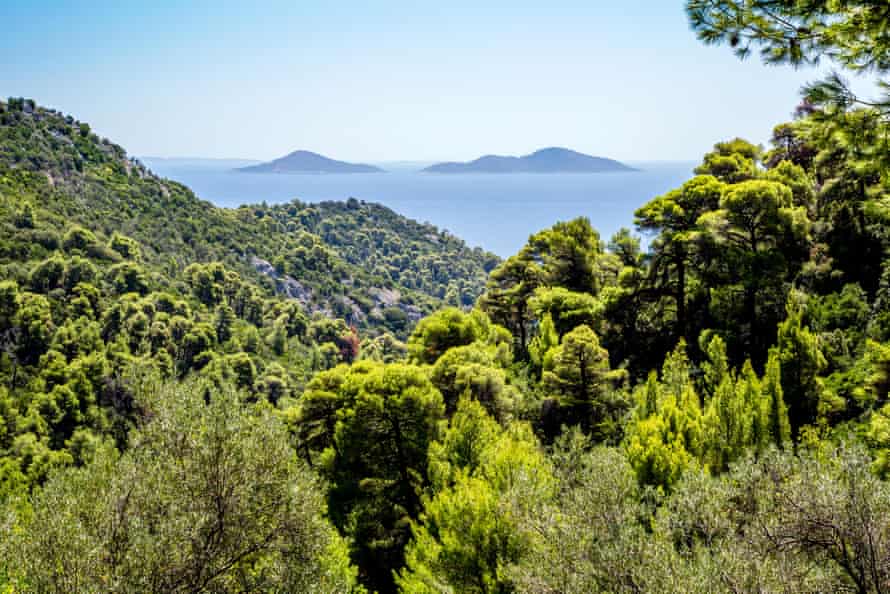
The pine-clad island of Alonissos in the north Aegean – overshadowed by its better-known neighbours Skopelos and Skiathos – was catapulted into international consciousness in 1992 through the establishment of the Alonissos national marine park, the first in Greece and still the largest protected marine area in Europe. Its waters shelter the critically endangered Mediterranean monk seal, plus dolphins, whales and rare seabirds. There are daily boat trips to the park’s 28 islands and outcrops, during which passengers can swim from the beach of Kyra Panagia island, which, intriguingly, belongs to Mount Athos. Its monastery of the Virgin Mary is open to the public and inhabited by two monks, one of whom, Father Chariton, was previously a chef in Camden Town, London.
The latest novelty is the first-ever Greek underwater museum, a perfectly preserved shipwreck dating from 425BC, which lies on the seabed beside the island of Peristera. The ship carried 4,000 amphorae, or wine urns, that can still be seen by recreational scuba divers who come with a guide – unusually, as other similar wrecks in Greece are off-limits for fear of theft. Non-divers can explore the shipwreck virtually via the museum website.
Eye-catching marine parks and shipwrecks aside, Alonissos is really about forested treks, relaxing swims and dozy unfussiness. There are only two settlements: the tranquil capital, Chora, and the small, busy port of Patitiri, where most of the hotels cluster. The roads to the beaches are surprisingly good. Leftos Gialos has sun loungers and two beach bars; at Kokkinokastro, turquoise waters reflect a dramatic red promontory; Megalos Mourtias has grand views towards Skopelos; and from Chrissi Milia, the most accessible beach, a footpath leads over the headland to Milia for a more secluded sunbathe.
Where to stay
Hotel Yalis (doubles from €75 B&B) above Patitiri has a great swimming pool and bar, as well as an excellent breakfast buffet, while the brightly furnished Atrium Alonissos (doubles from €80 B&B) nearby delivers views over the Rousoum Gialos beach and is competitive on comfort and facilities.
Where to eat
The best places are in Chora: the stylish menu of Thea features pork fillet in a red dessert wine sauce with mushrooms and sweet potatoes; vine-draped Astrofegia, occupying a stone mansion, is a traditional romantic taverna; and bubbly cafe-cum-piano-bar Hayati, with a panoramic terrace, supplies live entertainment in high season.
How to get there
Alonissos is reached by ferry from the port of Volos in mainland Greece (five-hour crossing), from Skiathos (two hours) and, in season, from Thessaloniki (4½ hours). The quickest way from Athens is via ferry from Mantoudi (two hours) on the huge island of Evia, which is linked by bridge to the mainland, and two hours’ drive from the capital.
Kythnos, western Cyclades
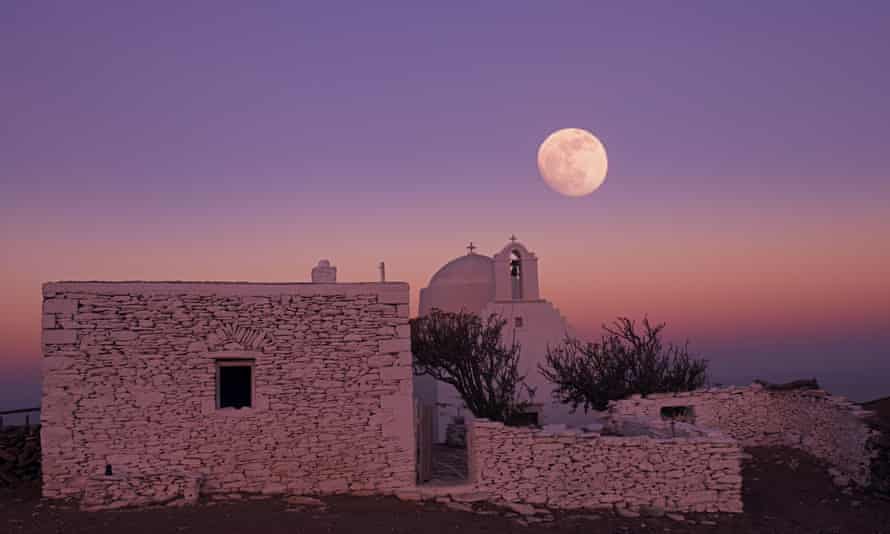
Only three hours by ferry from Athens’ Piraeus harbour, yet 30 years behind in temperament, Kythnos, with its off-grid simplicity and numerous unspoilt beaches, will awaken the inner hedonist in even the most cynical of tourists. This island still feels like Greece as it used to be: it didn’t have a credit card network until six years ago, and rented sunbeds and umbrellas have yet to arrive on its beaches.
Merihas, the sleepy arrival port, is not flush with accommodation options, but there are plenty at the genteel resort of Loutra, whose thermal springs were acclaimed by Greece’s King Otto in the 19th century. There are plans under way to upgrade the original neoclassical thermal complex into a modern spa as part of a new hotel project, but for now visitors can still enjoy the rush of warm groundwater for free by soaking in a natural “bathtub” rock formation on the right-hand side of the beach.

There’s also great swimming from the head-swivellingly spectacular sandy spit of Kolona, which joins the island with the small islet of St Luke; a hiking trail to Kastro tis Orias, the Byzantine medieval capital, five miles north-west of Loutra; and briny breezes under the tamarisks on the shaded beach of Kanala in the far south-east, also home to the Church of Panagia Kanala, one of the most important pilgrimage sites in the Cyclades.
Where to stay
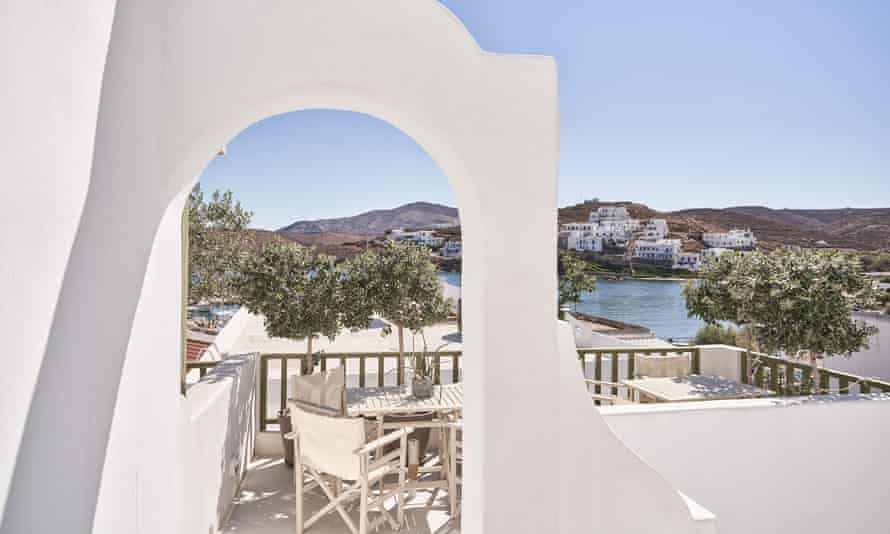
In the centre of the action at Loutra, Porto Klaras hotel (self-catering doubles from €100 a night) is a designer option. The convivial Villa Elena (doubles from €60 room-only, two-night minimum)above Martinakia beach is 10 minutes’ walk from Merihas.
Where to eat
Yachting club Sofrano at Loutra is a typical Greek meat-and-fish grill, while Margiora in Chora, the capital, has a more sophisticated bistro vibe and an impressive wine list. Islanders frequent the unassuming taverna To Kantouni on the Merihas waterfront for its kebabs and sfougato (local cheese croquettes).
There’s a whiff of nightlife in Chora: cafe/bar Apocalipsi has occasional live music, and the Kraken is a night owls’ haunt, where punch-packing cocktails start at €9.
How to get there
There are frequent ferries from Piraeus (three-hour voyage), although the quickest way to Kythnos is from the port of Lavrio (1½-hour crossing), about an hour’s drive south-east of central Athens.
Astypalea, Dodecanese islands
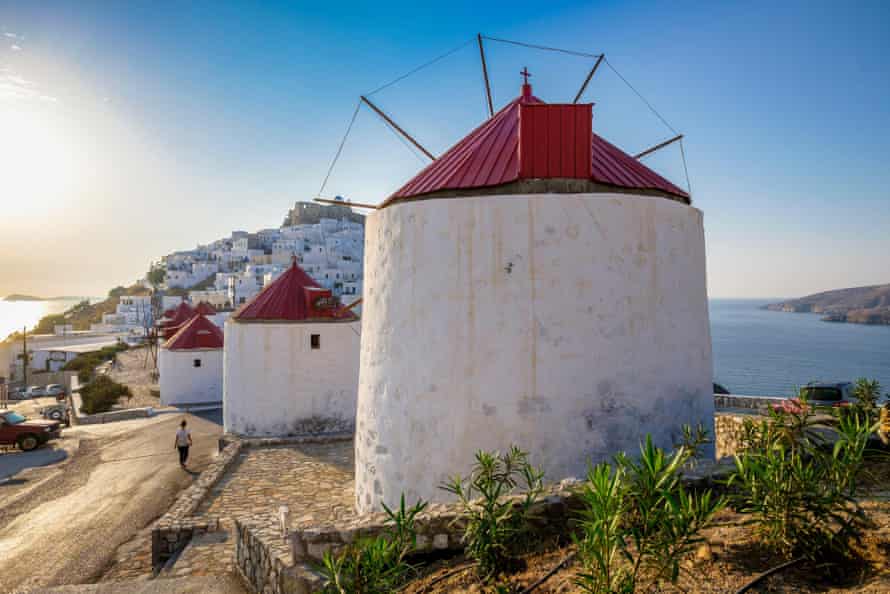
Bang in the middle of the Aegean, this butterfly-shaped island belongs politically to the Italianate Dodecanese, but it forms a cultural bridge with the Cyclades. Not only is it more whitewashed than the popular neighbouring islands of Rhodes and Kos, but its eight photogenic windmills also evoke the aesthetic of Mykonos. On the other hand, the 13th-century citadel in the capital, Chora, is unquestionably Venetian and, as a former part of Mussolini’s Mediterranean Empire, Astypalea has incorporated risottos and pasta – such as makarounes, a homemade, thick spaghetti – into its cuisine.
The island is thinking progressively in terms of sustainability. In partnership with Volkswagen, the Chora municipality has pledged to electrify its municipal fleet (buses, fire engines, police vehicles) from this year, and is planning to extend the scheme to rental cars and private vehicles via substantial discounts. Twelve charging points have been erected, with more to come (Athens only has 26).
As Astypalea is the last stop on every ferry route, the beaches are always uncrowded, and package tours are nonexistent. Vatses and Kaminakia, reached by dirt roads, are sandy, wide and safe; the sea at shaded Livadi is sparkling as it comes, while the caramel cove of Agios Konstantinos is served by a good taverna. The eastern “wing” is home to wild, solitary sweeps of sand, such as Plakes and Vathy.
Where to stay
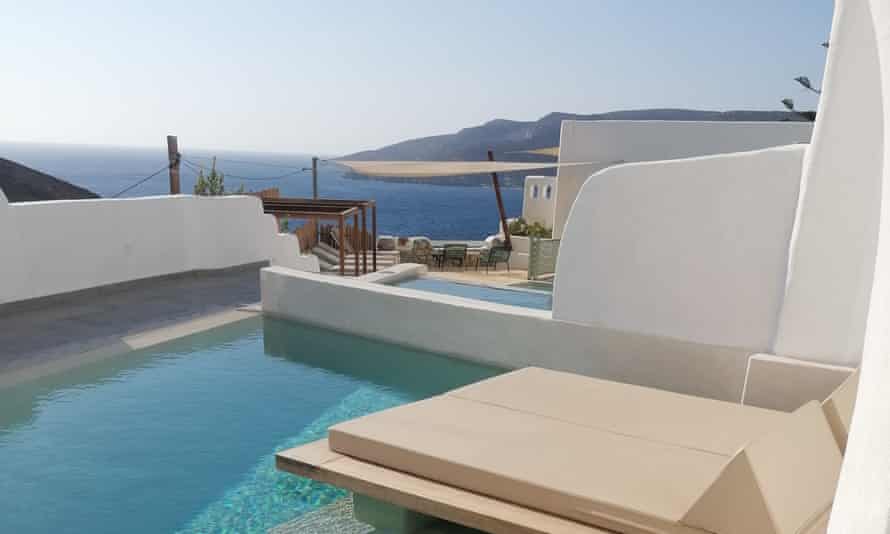
Pylaia Boutique Hotel & Spa (doubles from €98 B&B), on a slope overlooking Chora, is a designer’s dream, similar in style to the kind found in Santorini. Closer to town is the classy, adults-only Chrysalis Boutique hotel (doubles, all with sea views, from €60 B&B).
Where to eat
Sun-bleached taverna Agoni Grammi at Chora serves inexpensive, delicious fare, including Italian-Astypalean fusion specialities such as clam risotto. For a splash-out dinner, Akti offers fine dining including fish meatballs, octopus sautéed in ouzo and lobster linguine.
How to get there
The ferry from Piraeus takes 10 hours, but a new, fast catamaran service which started last summer takes 5½ hours from Rhodes and 1¾ hours from Kos
Gialova, Peloponnese peninsula

Most Greeks would struggle to find Gialova on a map. The small holiday village in the south-western Peloponnese is a few miles south of the Costa Navarino mega resort – which does get a flash of recognition – and shares the same coast and regional attractions, but at a fraction of the cost.
Gialova ticks all the boxes. It’s walking distance from the Gialova lagoon and nature reserve, one of the prime bird habitats in Greece, where specialist guides offer birdwatching tours. The reserve is also home to the only European colony of the fiercely protected African chameleon.
In the other direction is ancient Pylos, where excavations have unveiled a large Mycenaean-era palace, popularly named Nestor’s Palace after the local king in the Iliad. The site is imaginatively laid out with raised visitor walkways that allow a thorough exploration. Modern Pylos is an unpretentious port overlooked by Niokastro (New Castle), an impressive 16th-century hexagonal fort with striking views.
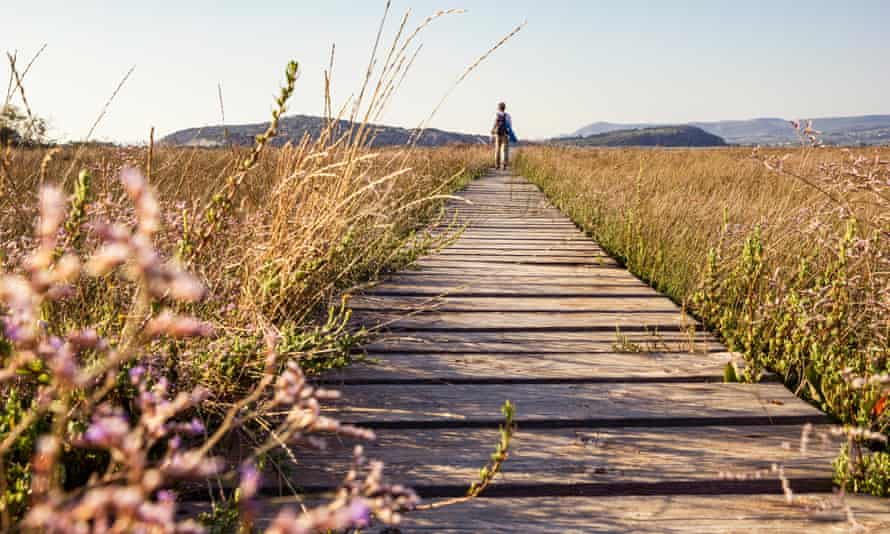
To top it all, just the other side of the nature reserve is the perfect, quasi-circular curve of Voïdokoilia, one of Greece’s most gorgeous beaches, which is backed by sand dunes. The bird’s eye view of it from the ruins of Paleokastro (Old Castle) more than compensates for the necessary hour’s stiff climb up.
Where to stay
Family-owned and pleasingly old-fashioned, though with smart rooms, Zoe Resort (doubles from €120 B&B) is beside a wide beach shaded by mulberry and plane trees. In late August and September lovelorn chameleons hop about looking for a mate in its gardens, and there’s a pool. Nearby Erodios is a comfortable family campsite with bungalows (doubles from €55 a night).
Where to eat
Rural nostalgia rules in Gialova: the Natura, Zoe’s restaurant, is a vintage taverna easily accessed from the beach, where guests can inspect the day’s dishes in the kitchen. Further on, Spitiko is a Cypriot restaurant sought after for its seftalia meatballs.
How to get there
The extension of the highway from the city of Kalamata has cut driving time to less than an hour. Kalamata is around a 2¾-hour drive south-west from Athens.
Ioannina, Epirus region

The capital of the north-west mainland region of Epirus, facing the Pindus mountain range on the banks of Lake Pamvotis, Ioanninna is a chief contender for Greece’s prettiest non-coastal town. It achieved prominence in the early 1800s under the rule of the notorious Ali Pasha, who made a lasting impression on Lord Byron.
Although 2022 marks 200 years since his death while fighting Sultan Mahmud II, his spirit never abandoned the town. The current fortress was restored during his reign and the mosques he worshipped in, the palace he built and his tomb are all city landmarks. As a result, Ioannina radiates more of a feeling of Ottoman past than any other town in Greece.
A 19-mile tour of the lake by bike offers views of the town and the mountains. A second day could be spent at the island on the lake, reached by passenger boat, with its fishing village, Ali Pasha Museum and seven Byzantine monasteries.
A 40-minute drive away is Metsovo, Greece’s mountain capital, bordering Pindos national park. In the winter it’s a ski resort; in summer it’s a hub for adrenaline junkies, with mountain biking, hiking, canyoning, kayaking and rafting on the River Aöos. As the birthplace of two of Greece’s major philanthropists, George Averoff and Michael Tositsas, who built universities, hospitals and more, it has a remarkable cultural heritage, punctuated by the Averoff Gallery of Greek Painting and the Tositsa Museum of Folk Art.
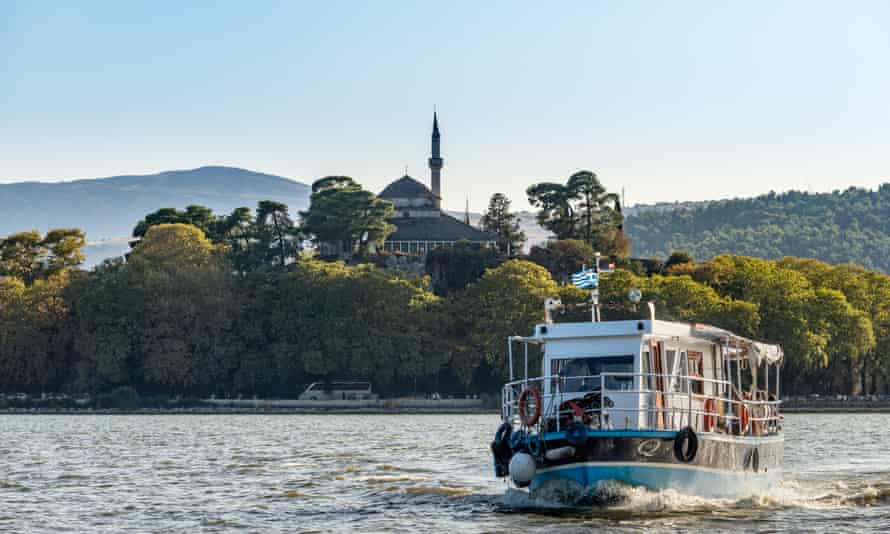
Where to stay
Hotel du Lac (doubles from €120 B&B) is atmospherically sited by the waterside. For more of a town buzz, Kamares (doubles from €120 B&B) is a boutique renovation of an 18th-century mansion. For an unforgettable experience, the Grand Forest Metsovo (doubles from €160 B&B) is an alpine-style grande dame that sits on a private hill overlooking Metsovo, surrounded by beech and black-pine forest.
Where to eat
The clutch of tavernas on the island offer typical lake dishes: frogs’ legs, stone-baked eel, carp in tomato sauce, and crayfish with garlic and walnuts. Frontzou Politia in town provides mountain fare, such as vegetable and cheese pies, mutton with feta cheese, and goat shank.
How to get there
Ioannina is pretty accessible: it’s one hour by car from Igoumenitsa, terminus of ferries from Italy, or an easy 4½-hour drive from Athens, while the new Egnatia motorway has cut the driving time from Thessaloniki to just three hours.
Athos region, Central Macedonia

The Athos region in eastern Halkidiki is best known for the Holy Mountain and its monks’ republic, but the monastic administration covers only two-thirds of the peninsula. The rest is an amalgamation of dozens of semi-deserted beaches, lush hikes, archaeological sites such as Stagira, birthplace of Aristotle, and peaceful seaside towns including Ierissos and Olymbiada.
The lodestar of attractions is, of course, Mount Athos, which can be circumnavigated by boat, and its administrative centre of Ouranoupoli, with its icon galleries, but another showstopper is Ammouliani, a pinch-me island of pristine beaches. Here Alykes, a wide bay with sand the colour and consistency of milled oats, is one of Greece’s best-kept secrets, while many find the translucent shallows of Megali Ammos, one mile east, even more enticing.
Snorkellers can book excursions to the crystalline waters of the rocky Drenia archipelago. Hikers should attempt at least part of the meandering 18-mile Aristotelian Walk (according to legend, he was a great walker), a well-signposted, shaded woodland trail from New to Ancient Stagira .
Where to stay

The sumptuous Eagles Palace (doubles from €134 B&B, three- night minimum) is a five-star beach resort whose six restaurants render its premium half-board option very attractive (from €48 adult). For a lower-key vibe, Hotel Liotopi (doubles from €99 half-board) is a friendly family-run hotel at Olymbiada, and a far cry from other crowded Halikdiki resorts.
Where to eat
The Athos region takes pride in its Aegean seafood, but because of the stream of pilgrims and the monks’ influence, there are vegan dishes served in just about every taverna. Kamares, at the aforementioned Eagles Palace hotel, is curated by chef Arnaud Bignon, owner of the two-Michelin starred Spondi in Athens, so dinner here is a must.
For imaginative seafood, try the spicy mussel stew at Akroyiali in Olympiada and the sea bass ceviche at Kokkinos in Ouranoupoli.
How to get there
Ouranoupoli is an easy 1½ hours’ drive east of Thessaloniki.
 Top Naija News: Nigerian News, Breaking News Nigeria and World News Top Naija News is a daily news publication in Nigeria, delivering the latest breaking news in Nigeria and around the world.
Top Naija News: Nigerian News, Breaking News Nigeria and World News Top Naija News is a daily news publication in Nigeria, delivering the latest breaking news in Nigeria and around the world.
